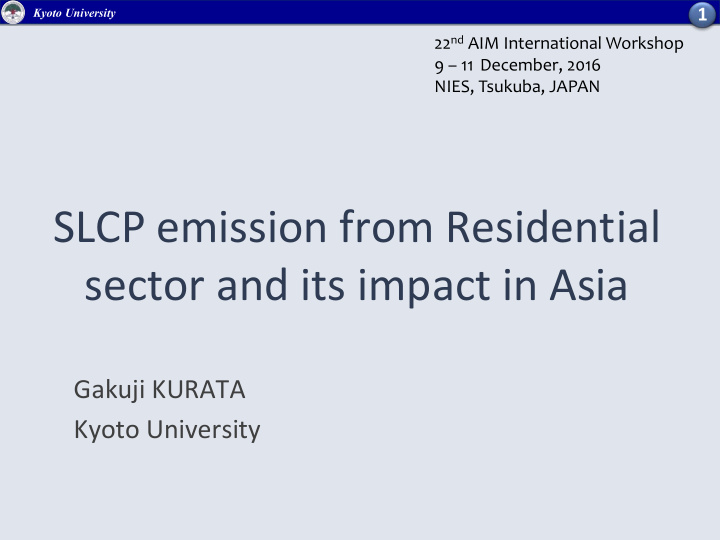



1 Kyoto University 22 nd AIM International Workshop 9 – 11 December, 2016 NIES, Tsukuba, JAPAN SLCP emission from Residential sector and its impact in Asia Gakuji KURATA Kyoto University
2 Kyoto University Developed Country & A part of Urban Area of Developing Country. How to minimize the energy consumption. (Mainly electricity) How to reduce the environmental loading. (Municipal waste and wastewater) How to introduce the low carbon lifestyle. Target BC, OC, Wood Fireplace of PM2.5, NMVOC Residential Sector • Energy Poverty Model • Indoor Air Pollution largest health Risk • Direct emission of GHG and SLCP How to reduce the Solid fuel use . (Biomass, Coal ) How to introduce the high efficiency equipment How to accelerate the electrification. Developing Country and Rural Area
3 Kyoto University 3 Direct emission of SLCP from Residential sector Combustion of Solid Fuel (Coal, Biomass) in Residential sector causes Climate Impact as SLCP 0.5 ℃ BC + CH4 Indoor Air UNEP/WMO (2011) Local and Regional Air Pollution Pollution In Jan, Feb 50% of PM2.5, 60-80% of BC 90% of OC are come from Residential sector Liu et. al., (2016)
4 Kyoto University Premature death due to indoor air pollution in the World is 4.3 million people (WHO ,2012) China: 1.46 million India: 1.25 million Indoor air pollution is the largest factor in the environmental risk. Death Attributable to Household air pollution (per 100 000 capita) [WHO 2012] (WHO, 2004)
5 Kyoto University Rural Area (WHO, 2013) In rural of China and India, more than 50% of energy sources used in the household is solid fuels such as coal and biomass (firewood, crop residue and animal dung).
6 Kyoto University China, BC emission China, CO2 emission SSP2 Ref + High electrification SSP2 Ref + High electrification India, BC emission India, CO2 emission SSP2 Ref + High electrification SSP2 Ref + High electrification
7 Kyoto University CO2, Residential sector, China BC, Residential , China Heating Heating, Biomass Lighting (Oil) Cooking Cooking, Biomass Hot water SSP2 Reference CO2 emission by Technology for Residential sector 2010-2050 China IND Emisison/toe 90000000 CO2 emission, India 80000000 Residential Sector There are no difference between 70000000 60000000 Countermeasure cases for Climate Change 50000000 40000000 30000000 Because, the Climate Policy mainly focus 20000000 year on the Power generation, industrial sector 10000000 0 and Transportation sector. 2010 2011 2012 2013 2014 2015 2016 2017 2018 2019 2020
8 Kyoto University Lack of Future Service demand estimation Because there are large differences in lifestyle between regions, it is difficult to estimate the service demand in the future residential sector. Lack of Technology Information Bottom-up model carries out technology selection according to economic rationality. However, in addition to the lack of information on the initial cost and running cost of the household equipment, it differs greatly from country by country. Lack of Emission Factor for air pollutants. The emission factors of air pollutants from household equipment are extremely limited.
9 Kyoto University Future Emission Estimate from Residential Sector Population Floor area SSP Scenario Ownership of Heating / Cooling Electric Appliance Degree day 2010 ~ 2030 Estimation of Energy service demand for Urban/Rural Hot water Other Home Cooking Lighting Cooling Heating Supply Appliance Enduse Technology Selection Model AIM/Enduse Model Emission Factor Energy consumption / Fuel type / Purpose Emission of Air Pollutant
10 Kyoto University Future estimation of Energy Consumption of Residential Sector (case study for China) Rural Urban Per Capita Energy Consumption (GJ/cap/year) Urban GJ/cap Per Capita Energy Consumption (GJ/cap/year) 9 8.53 9 7.70 8 7.74 8 7.36 7 7 冷房 冷房 6 電化製品 6 電化製品 給湯 5 5 給湯 照明 4 4 照明 調理 3 3 調理 暖房 2 2 暖房 1 1 0 0 2010 2015 2020 2025 2030 2010 2015 2020 2025 2030
Kyoto University Per Household Energy Per Household Energy Consumption for Heating (toe) Consumption for Cooking (toe) Estimated Trend of Share of technology Cooking/Rural Heating/Rural 11
12 Kyoto University SLCP (and Air Pollutants) emission from Residential Sector in Rural and Urban area China. Target Pollutants BC , CO, NO X , OC, PM2.5, PM10, SO 2 , VOC Estimation of Emission from Urban and Rural area : 𝑁 𝑣𝑠,𝑔,𝑂 = 𝐹 𝑣𝑠,𝑔,𝑂 × 𝐹𝐺 𝑔,𝑂 𝑁: Emission of SLCP 𝑣𝑠: Urban / Rural 𝑔: type of Fuel 𝑂: type of SLCP 𝐹𝐺: Emission Factor 𝐹: Household energy consumption
13 Kyoto University Future Emission of Air Pollutant from Residential Sector Urban Rural
14 Kyoto University 16 8 石炭 LPG Coal LPG 14 12 6 10 4 8 6 2 4 2 0 0 2010 2015 2020 2025 2030 2010 2015 2020 2025 2030 70 5 バイオマス Biomass 天然ガス 60 Natural Gas 4 50 40 3 30 2 20 10 1 0 0 2010 2015 2020 2025 2030 2010 2015 2020 2025 2030 2 Kerosene 灯油 1.5 1 0.5 0 2010 2015 2020 2025 2030
15 15 Kyoto University Indoor Air Pollution Future Emission Scenarios of Residential Sector Regional Air Pollution Contribution of Residential Sector Average Indoor exposure of PM2.5 multiplied by population.
16 Kyoto University 1. It is extremely important to improve the accuracy of future estimates of the emissions from the residential sector, as SLCP emissions are large and the impact of indoor air pollution is serious. 2. In this year, we are conducting research focusing on the estimation of the service demand of the residential sector and the estimation of the reduction potential by AIM/Enduse model. 3. After that, we will estimate the contribution of pollutants from the residential sector to local and regional air pollution and estimate the impact to the indoor air pollution.
17 Kyoto University Thank you for your attention
Recommend
More recommend